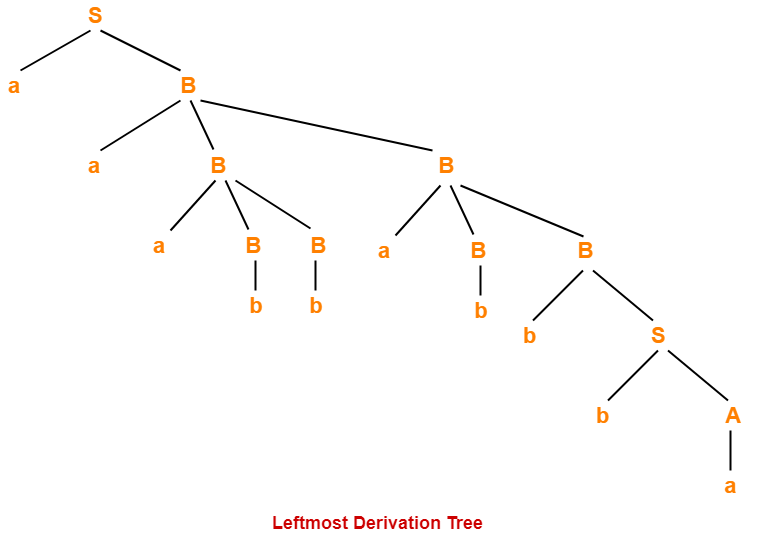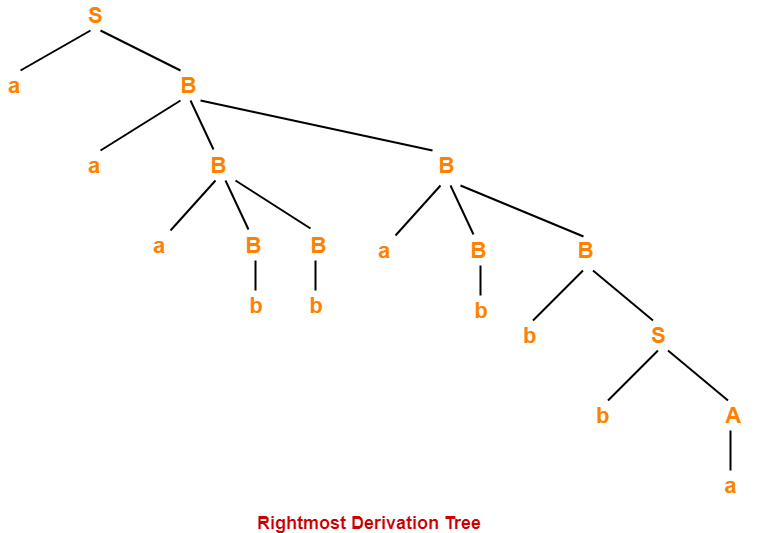Question
In: Computer Science
Given a grammar G, G = (Ν, Σ, Π, S), where Ν = { ... }...
Given a grammar G, G = (Ν, Σ, Π, S), where
Ν = { ... }
Σ = { ... }
Π = { ... }
S is ... For a string ... write
(a) A leftmost derivation
(b) A rightmost derivation
Solutions
Expert Solution
Leftmost derivation
• Leftmost nonterminal is replaced in each step
Rightmost derivation
• Rightmost nonterminal is replaced in each step
Example
• Grammar
S → AB, A → a, B → b
• Leftmost derivation for ab-
S ⇒ AB ⇒ aB ⇒ ab
• Rightmost derivation for ab-
S ⇒ AB ⇒ Ab ⇒ ab
For unambiguous
Consider the following grammar-
S → aS / ∈
The language generated by this grammar is-
L = { an , n>=0 } or a*
All the strings generated from this grammar have their leftmost derivation and rightmost derivation exactly same.
Let us consider a string w = aaa.
Leftmost Derivation-
S → aS
→ aaS (Using S → aS)
→ aaaS (Using S → aS)
→ aaa∈
→ aaa
Rightmost Derivation-
S → aS
→ aaS (Using S → aS)
→ aaaS (Using S → aS)
→ aaa∈
→ aaa
Clearly,
Consider the following grammar-
S → aB / bA
S → aS / bAA / a
B → bS / aBB / b
(Unambiguous Grammar)
Let us consider a string w = aaabbabbba
Now, let us derive the string w using leftmost derivation.
Leftmost Derivation-
S → aB
→ aaBB (Using B → aBB)
→ aaaBBB (Using B → aBB)
→ aaabBB (Using B → b)
→ aaabbB (Using B → b)
→ aaabbaBB (Using B → aBB)
→ aaabbabB (Using B → b)
→ aaabbabbS (Using B → bS)
→ aaabbabbbA (Using S → bA)
→ aaabbabbba (Using A → a)

2. Rightmost Derivation-
- The process of deriving a string by expanding the rightmost non-terminal at each step is called as rightmost derivation.
- The geometrical representation of rightmost derivation is called as a rightmost derivation tree.
Example-
Consider the following grammar-
S → aB / bA
S → aS / bAA / a
B → bS / aBB / b
(Unambiguous Grammar)
Let us consider a string w = aaabbabbba
Now, let us derive the string w using rightmost derivation.
Rightmost Derivation-
S → aB
→ aaBB (Using B → aBB)
→ aaBaBB (Using B → aBB)
→ aaBaBbS (Using B → bS)
→ aaBaBbbA (Using S → bA)
→ aaBaBbba (Using A → a)
→ aaBabbba (Using B → b)
→ aaaBBabbba (Using B → aBB)
→ aaaBbabbba (Using B → b)
→ aaabbabbba (Using B → b)

|
NOTES
|
Here,
- The given grammar was unambiguous.
- That is why, leftmost derivation and rightmost derivation represents the same parse tree.
Related Solutions
For a grammar G with the productions where G = ( {S, A, B}, {a, b},...
Consider the context-free grammar G = ( {S}, {a, b}, S, P) where P = {...
1. Consider the regular grammar G given below: S → aS|aA|bB|λ A → aA|bS B →...
Let G = (AN , AT , S, P) be a context-free grammar in Chomsky normal...
Simplify the grammar G. Does L(G) contain ε ? S -> A B C | B...
The position of a 50 g oscillating mass is given by x(t)=(2.0cm)cos(10t−π/4), where t is in...
In a bubble chamber experiment, the decay of a Σ+ particle into a π+ particle and...
Find Consider the following context-free grammar G: S --> T#T T --> C A --> aA...
For pure Aloha system, prove that the throughput S=Ge-2G, where G is the traffic load, given...
The following hypotheses are given. H0 : π ≤ 0.81 H1 : π > 0.81 A...
- Using the Arizona Wuhan seafood market virus isolate, MN997409.1, run BLAST against the RefSeq Representative genomes...
- ACME manufacturing is a low-cost producer of a single, commodity product: RGL-01. Standard overhead cost information...
- Waterways for Chapter 9 (WCP9sum) Summer Waterways Corporation is preparing its budget for the coming year....
- A bar of length ℓ lies on the ?̂-axis with its center at the origin. A...
- Explain how research may be finding risks in sport when many used to think that sport...
- 1. Compound A is three times more soluble in diethyl ether than in water, so its...
- WHAT are the non-visible controls stored in Visual Studio IDE
 venereology answered 2 years ago
venereology answered 2 years ago